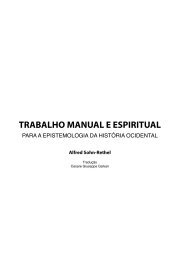Perversion the Social Relation
Perversion the Social Relation
Perversion the Social Relation
- No tags were found...
You also want an ePaper? Increase the reach of your titles
YUMPU automatically turns print PDFs into web optimized ePapers that Google loves.
Contamination's Germinations 201fine but lose his sense of smell, but for <strong>the</strong> most part we are kept in <strong>the</strong>present, be it morning, afternoon, evening, or night. Most importantly,however, for our sketch of <strong>the</strong> drives, is that structurally <strong>the</strong> text pushestoward closure, resolution, an end to <strong>the</strong> day, knowledge of <strong>the</strong> successof <strong>the</strong> surgery, completion of activities. Although any day-in-<strong>the</strong>-life-oftext has a predetermined ending—nighttime, but occasionally dawn—what are we to make of this death-drive structure of conclusion, giventhat Accident's concern with radioactive contamination is by definitionnot a one-day gig? This death-drive structure, <strong>the</strong>refore, turns out to beperverse: as we arrive at <strong>the</strong> end, <strong>the</strong> narrative fragments, particle-izes,condenses meanings, ra<strong>the</strong>r than resolves into quiescence.The tension between <strong>the</strong> limit of <strong>the</strong> day-in-<strong>the</strong>-life genre and <strong>the</strong>subject of radioactive contamination goes beyond simply a tension betweenform and content. As I noted earlier, Brooks insists that narrative'sdeath drive aims toward conclusion. In Accident <strong>the</strong> destination isalready reached at <strong>the</strong> outset as <strong>the</strong> novel begins in <strong>the</strong> future perfect."On a day about which I cannot write in <strong>the</strong> present tense, <strong>the</strong> cherrytrees will have been in blossom. I will have avoided thinking 'exploded,'<strong>the</strong> cherry trees have exploded, although only one year earlier I couldnot only think but also say it readily, if not entirely with conviction." 25The future perfect is a perverse tense, positing origin from <strong>the</strong> vantage ofwhat is ahead. If <strong>the</strong> signifier always gains its signification retroactively,<strong>the</strong> future perfect perfectly reverses that temporality of meaning. It seeksto unify <strong>the</strong> moment of narration with <strong>the</strong> moment narrated, to close <strong>the</strong>gap between telling and tale. Like contamination itself, <strong>the</strong> future perfectrelies on contiguity, but where contamination's contiguity is spatial,<strong>the</strong> future perfect's is temporal. Contiguous temporality is admittedlya bizarre notion, since spatiality is <strong>the</strong> dimension through which contiguityconventionally operates; contiguous temporality seems to divvy uptime's flow into particles. Temporality, moreover, is more often viewedas a smooth trajectory, in which certain moments might be singled outof <strong>the</strong> flow, but none<strong>the</strong>less <strong>the</strong> sense of <strong>the</strong> dynamics of time relies ona non-pixelated, non-fragmented understanding. Analepsis and prolepsisin narrative can serve to fragment time and disrupt <strong>the</strong> flow. Like<strong>the</strong> sedimentations of meaning around certain fragments of languagewordsor phrases activated by <strong>the</strong> radio, as we saw above—that signal<strong>the</strong> workings of <strong>the</strong> life drive's combinatory powers, a contiguous temporalityof <strong>the</strong> future perfect indicates <strong>the</strong> life drive at work in time as








